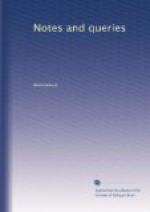"Incidis in Scyllam,” &c. (Vol. ii., p. 85.).—MR. C. FORBES says he “should be sorry this fine old proverb should be passed over with no better notice than seems to have been assigned to it in Boswell’s Johnson,” and then he quotes some account of it from the Gentleman’s Magazine. I beg leave to apprise MR. FORBES that there is no notice whatsoever of it in Boswell’s Johnson, though it is introduced (inter alia) in a note of Mr. Malone’s in the later editions of Boswell; but that note contains in substance all that MR. FORBES’S communication repeats. See the later {142} editions of Boswell, under the date of 30th March, 1783.
C.
Dies Irae (Vol. ii., p. 72. 105.).—Will you allow me to enter my protest against the terms “extremely beautiful and magnificent,” applied by your respectable correspondents to the Dies Irae, which, I confess, I think not deserving any such praise either for its poetry or its piety. The first triplet is the best, though I am not sure that even the merit of that be not its jingle, in which King David and the Sybil are strangely enough brought together to testify of the day of judgment. Some of the triplets appear to me very poor, and hardly above macaronic Latin.
C.
Fabulous Account of the Lion.—Many thanks to J. EASTWOOD (Vol. i., p. 472.) for his pertinent reply to my Query. The anecdote he refers to is mentioned in the Archaeological Journal, vol. i. 1845, p. 174., in a review of the French work Vitraux Peints de S. Etienne de Bourges, &c. No reference is given there; but I should fancy Philippe de Thaun gives the fable.
JARLTZBERG.
Caxton’s Printing-office (Vol. ii., p. 122.).—The abbot of Westminster who allowed William Caxton to set up his press in the almonry within the abbey of Westminster, was probably John Esteney, who became abbot in the year 1475, and died in 1498. If the date mentioned by Stow for the introduction of printing into England by Caxton, viz. 1471, could be shown to be that in which he commenced his printing at Westminster, Abbot Milling (who resigned the abbacy for the bishopric of Hereford in 1475) would claim the honour of having been his first patron: but the earliest ascertained date for his printing at Westminster is 1477. In the Gentleman’s Magazine for April, 1846, I made this remark:
“There can, we think, be no doubt that the device used by Caxton, and afterwards by Wynkyn de Worde, (W. 4.7 C.) was intended for the figures 74, (though Dibdin, p. cxxvii, seems incredulous in the matter), and that its allusion was to the year 1474 which may very probably have been that in which his press was set up in Westminster.”
Will the Editor of “NOTES AND QUERIES” now allow me to modify this suggestion? The figures




